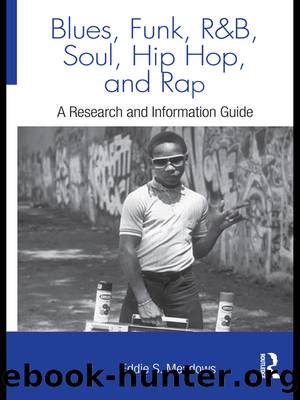Blues, Funk, Rhythm and Blues, Soul, Hip Hop, and Rap by Meadows Eddie S.;

Author:Meadows, Eddie S.;
Language: eng
Format: epub
Tags: Arts
Publisher: Taylor & Francis Group
Published: 2010-05-10T00:00:00+00:00
Global studies
789. N.A. âTokyoâs Round Mound of Sound.â Ebony, October 1976, 113.
Details the dissemination of African American music by an Air Force sergeant in Tokyo who developed a wide following by playing disco, rhythm and blues, and soul music on his radio show.
790. N.A. âSoul Explosion Rocks Land of Rising Sun.â Ebony, July 1975, 42.
Covers American soul music artists who have toured Japan (e.g. The Three Degrees, The Four Tops, the Stylistics) and local groups like The Finger Five and the Soul Mates who have been influenced by American soul music.
791. Browne, Kimasi Lionel John. ââSoul or Nothingâ: The Formation of Cultural Identity on the British Northern Soul Scene.â PhD dissertation, University of California, Los Angeles, 2005.
Research focuses on a working-class British subculture that has adopted African American cultural products as their own cultural expression. Documents obscure African American soul music from Motown and other record labels and its affective work in forming emotional, social, economic and cultural identity in the predominantly male, white and working-class Northern Soul scene in England from 1967 to around 2005. Fieldwork was conducted in these âundergroundâ communities in England, Wales and the Republic of Ireland.
792. Garland, Phyl. âSoul to Soul.â Ebony, June 1971, 79.
Touted as a return to the roots of African American music, the Soul to Soul concert was held in Accra, Ghana in 1971. The cultural exchange (featuring Roberta Flack, Eddie Harris, Les McCann and Wilson Pickett) was a huge success; the concert was also filmed.
793. Nowell, David. Too Darn Soulful: The Story of Northern Soul. London: Robson Books, 2001.
A thorough discussion of the British dance scene. The book is permeated with interviews and facts, and describes the social context that spawned the British love of African American popular music from the 1960s to 2001. The interviews cover the fansâ love of artists from the Motown era to contemporary artists like Fatboy Slim.
794. Wright II, Jeffrey Marsh. ââRussiaâs Greatest Live Machineâ: Disco, Exoticism, and Subversion.â Masters thesis, University of North Carolina, Chapel Hill, 2007.
In 1978 European disco group Boney M gave ten concerts in Moscow. Despite being the guests of the government, the group was censored because they performed âRasputin,â one of their biggest hits, a signifier of âRussiannessâ (rather than âSovietnessâ). The government deemed the song unacceptable for performance or release. The authorâs musical analysis coupled with the Soviet rejection of the song revealed a confluence of musical signification, exoticism, and the relationship of music and politics.
Download
This site does not store any files on its server. We only index and link to content provided by other sites. Please contact the content providers to delete copyright contents if any and email us, we'll remove relevant links or contents immediately.
The Goal (Off-Campus #4) by Elle Kennedy(12556)
Kathy Andrews Collection by Kathy Andrews(10616)
Diary of a Player by Brad Paisley(6889)
What Does This Button Do? by Bruce Dickinson(5565)
Assassin’s Fate by Robin Hobb(5288)
Big Little Lies by Liane Moriarty(4920)
Pale Blue Dot by Carl Sagan(4055)
Sticky Fingers by Joe Hagan(3474)
The Heroin Diaries by Nikki Sixx(2962)
The Death of the Heart by Elizabeth Bowen(2941)
Beneath These Shadows by Meghan March(2747)
The Help by Kathryn Stockett(2726)
Confessions of a Video Vixen by Karrine Steffans(2704)
How Music Works by David Byrne(2573)
Jam by Jam (epub)(2517)
Harry Potter 4 - Harry Potter and The Goblet of Fire by J.K.Rowling(2444)
Strange Fascination: David Bowie: The Definitive Story by David Buckley(2386)
Petty: The Biography by Warren Zanes(2255)
Darker Than the Deepest Sea by Trevor Dann(2232)
